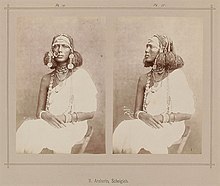Richard Buchta
Richard Buchta (born January 19, 1845 in Radlow ( Galicia ), † July 29, 1894 in Vienna ) was an Austrian African explorer , author and photographer . Although Richard Buchta's photographs were often reproduced in travelogues about East Africa up to the beginning of the 20th century, his publications afterwards were largely forgotten. Since the late 20th century, however, his work has regained importance in the history of photography in Africa .
life and work
At the age of 20 Buchta began extensive journeys through Germany, France, Hungary, the lower Danube countries , the Balkans , Turkey and Asia Minor. Among other things, he spent a year in Constantinople (today's Istanbul) and later three years in Cairo. From there he traveled to Khartoum and was commissioned by Governor General Gordon Pascha to explore the Egyptian Sudan. Buchta left Khartoum in August 1878 and arrived in Ladó on the Upper Nile in October . Here he was Emin Pascha's guest . Buchta used Ladó as a starting point and traveled as an observer and photographer with a particular interest in ethnology to various areas of southern Sudan and northern Uganda. Among other things, he lived in July / August 1879 with the Adio, who lived west of Ladó . In 1880 Buchta returned to Germany via Khartoum and published his photographs in 1881 as part of the book The Upper Nile Countries: People Types and Landscapes .
Buchta traveled to Egypt again in 1885. Among other places, he toured the desert around the Fajum oasis . Since 1886, Richard Buchta lived in Vienna, where he at first volume of travels in Africa of the African explorer s Junker Wilhelm s participated. Buchta died on July 29, 1894 at the age of 49.
Significance for the history of photography in Africa

Although Richard Buchta's photographs were often reproduced in travelogues about East Africa up to the turn of the century, his publications were largely forgotten in the 20th century. In the context of studies on the history of photography in Africa since the late 20th century, however, his photographs and their influence on ethnological studies and ideas about East Africa in European works have received renewed attention since the late 19th century. On the occasion of an exhibition of his photographs in 2015, the Pitt Rivers Museum , Oxford wrote : "His trip to the province of Equatoria (now parts of southern Sudan and northern Uganda) shaped the visual representation of its peoples in European literature for a generation by the important authors about the discovery of Central Africa at this time and was mostly reproduced in the form of graphic prints. "
Richard Buchta's photographs are in various collections in Oxford, Great Britain, such as the Pitt Rivers Museum and in the collections of the Weltmuseum in Vienna.
Works (selection)
- Bibliography of the works of Richard Buchta
- The upper Nile countries: people types and landscapes, represented in 160 photographs. With an introduction by Dr. R. Hartmann . Berlin, 1881
- Sudan and the Mahdi : the land, the people and the insurrection . Stuttgart, 1884
- Sudan under Egyptian Rule: Looking Back at the Last 60 Years . Leipzig, 1888
- as co-author: Dr. Wilhelm Junkers Travels in Africa, 1875–1878. Edited and edited by the traveler from his diaries . Volume 1. Hölzel, Vienna 1889. Full text online .
literature
- Friedrich Ratzel: Buchta, Richard . In: Allgemeine Deutsche Biographie (ADB). Volume 47, Duncker & Humblot, Leipzig 1903, p. 332 f.
- Buchta Richard. In: Austrian Biographical Lexicon 1815–1950 (ÖBL). Volume 1, Verlag der Österreichischen Akademie der Wissenschaften, Vienna 1957, p. 123.
- Inge Hofmann; Herbert Tomandl; Michael Zach. The first photos of the pyramids of Meroe north and south. Communications from the Anthropological Society in Vienna, Volume 116. Vienna, 1986. pp. 177–178
- David Killingray and Andrew Roberts: An Outline History of Photography in Africa to ca. 1940: History in Africa, Vol. 16 (1989), pp. 199-200, Cambridge University Press
- Christopher Morton. Richard Buchta and the Visual Representation of Equatoria in the Later Nineteenth Century. The African Photographic Archive: Research and Curatorial Strategies, pp 19-38., 2015
Web links
Individual evidence
- ↑ a b Christopher Morton, Darren Newbury: The African Photographic Archive: Research and Curatorial Strategies , Bloomsbury Publishing , 2015 ISBN 9781472591265 , pp. 42–44 [1]
- ↑ In the original: "On the occasion of an exhibition of his photographs in 2015, the Pitts Rivers Museum wrote:" His journey into Equatoria Province (now parts of South Sudan and northern Uganda) shaped the visual representation of its peoples in European literature for a generation, being celebrated and reproduced, mostly in engraved form, by all the major explorer-writers of central Africa in the period. " Pitt Rivers Museum. Richard Buchta's photographs of Equatoria, 1878–1880 ( en-GB )
- ^ Biography information for Buchta at the Southern Sudan Project. Retrieved June 5, 2020 .
| personal data | |
|---|---|
| SURNAME | Buchta, Richard |
| BRIEF DESCRIPTION | Austrian Africa explorer |
| DATE OF BIRTH | January 19, 1845 |
| PLACE OF BIRTH | Radlow , Galicia |
| DATE OF DEATH | July 29, 1894 |
| Place of death | Vienna |
